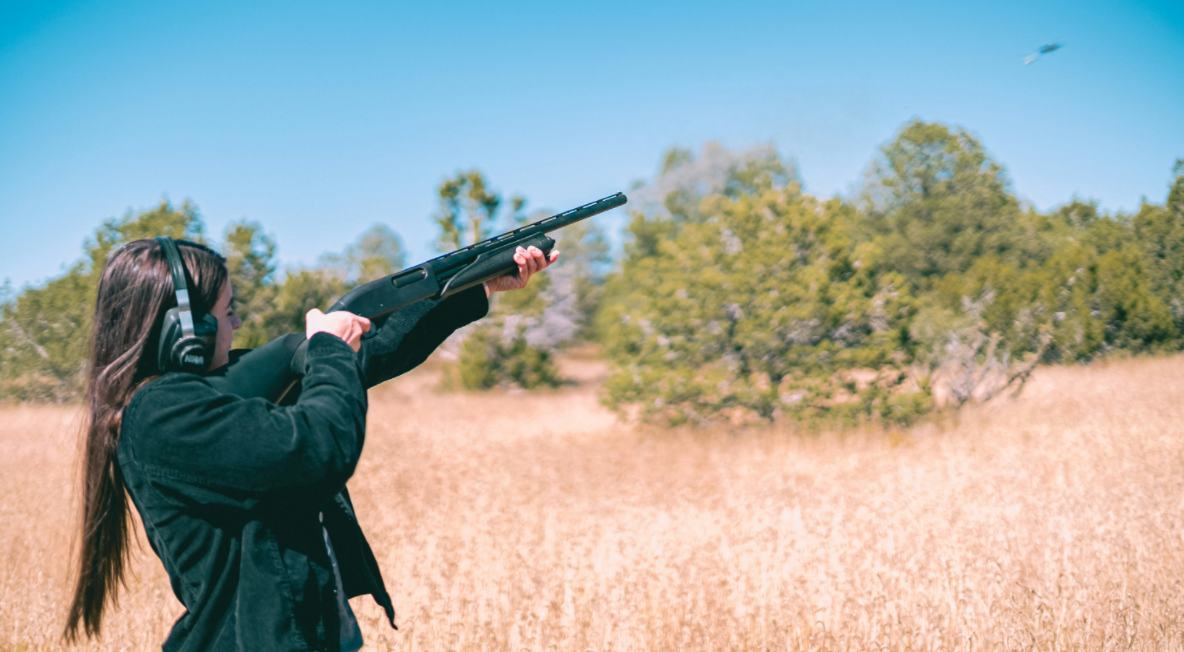Is your shotgun accurate enough to hit whatever you are targeting? Why do hunters pattern their shot shotguns? The simple act of patterning a hunter’s shotgun seems to be something most hunters never complete and thus miss out on valuable shots.
One should know how the gun behaves at different ranges and with different chokes to achieve the best results consistently. In this guide, we will explore the concept of shotgun patterning, its importance, proper procedures for patterning, and the factors affecting the dispersion of the shot.
Learn how to become a more effective hunter right from selecting the right patterning target to the correct positioning of your equipment.
What Is Shotgun Patterning?
Shotgun patterning is the method used to ascertain how the shot of a shotgun spreads about a given target range.
It entails using a gun to shoot several shots at a large piece of paper to see the dispersion of pellets. This type of illustration is known as the shot pattern and it is indeed a useful way of gauging your particular shotgun and its effectiveness.
When Should You Pattern a Shotgun?
Below are some of the key times when patterning is critical.
1. Before Hunting Season
This is a great opportunity to pattern your shotgun if you want to make sure you are ready for the field with an adequate configuration. It lets you make adjustments for your choke and ammo selection depending on the game and hunting environment.
2. After Changing Components
Changes such as putting a new barrel on your shotgun, changing the choke, or even firing different ammunition will affect the shot pattern. To ensure that your gun is still shooting correctly after making these changes, patterning them is mandatory.
3. Troubleshooting
If you have cases of failure in shot placements or poor target accuracy, you can also pattern to solve related issues. It can show choke issues, ammunition compatibility, or even deeper gunsmithing issues.
4. Regularly For Accuracy
It is recommended that a shotgun be patterned as often as possible even if you cannot alter the gun in any way. It is rather evident that shot patterns may vary with time, owing to such reasons as barrel wear and different types of ammunition.
What Are Some Factors Affecting Shotgun Patterning?
Several factors determine the direction and distribution pattern of shot pellets when fired at a target by a shotgun. Here are some of the fundamental aspects that we need to look at.
Gun-Related Factors
Choke is the biggest contributor to pattern density and spread. Chokes enable the constriction of the barrels at a certain point to reduce the pattern of the pellets.
- Full choke: This is a tight pattern that is perfect for long-range targets. And there are also different chokes including modified, skeet, and cylinder which restrain the shot string differently.
- Improved cylinder: The open pattern is appropriate for targets within the range of close vision.
- Barrel length: Longer barrels tend to give better patterning due to the increased velocity of the shot. However, the effect is not as strong as a choke.
- Barrel bore: This takes place because even the variation of a single caliber of barrel can influence the density of the pattern.
- Gun fit: Correct fitting of the guns maintains pointing and minimizes human error, which in turn impacts the pattern placement.
Ammunition-Related Factors
- Shot size: The pellets at short ranges produce tighter patterns, but they cannot penetrate deeply. This is due to bigger shot sizes placing more shots on target but spreading them out over a wider area.
- Shot type: There are lead shot, steel shot, and tungsten shots differently in their density and hardness thus resulting in different patterns.
- Wad: It is placed between the shot and the powder and has some effect on pellet dispersion.
- Powder charge: More velocity usually yields denser patterns, but excessive velocity can impede pattern density.
Environmental Factors
- Temperature: Temperature has a small effect as higher temperatures can increase the shot dispersion marginally.
- Humidity: Very high humidity can impact shot velocity and pattern density.
- Wind: The wind can affect the direction of the shot, which distorts the pattern placement.
Shooter-Related Factors
Gun mount: Correct selection of gun mount provides repetitive positioning and results in a better and more even pattern.
Trigger pull: A controlled and uniform trigger pull helps maintain the aim point and impacts the shot group firing.
How to Pattern a Shotgun?
Patterning a shotgun is essential for understanding your firearm’s performance and making informed decisions about choke, ammunition, and shooting technique. Here’s a step-by-step guide:
Equipment and Preparation
- Large sheet of paper: Butcher paper or similar material works well.
- Tape or tacks: To secure the paper to a sturdy backing.
- Measuring tape: To accurately determine distances.
- Safety glasses: Protect your eyes from shot pellets.
- Ear protection: Essential for noise reduction.
- Stable shooting rest: For consistent shot placement.
- Ammunition and chokes: You want to test different ones.
Choose the Ideal Patterning Distance
The ideal patterning distance depends on your primary hunting or shooting purpose:
- Clay target shooting:21 yards is standard.
- Upland bird hunting: 30 to 35 yards is common.
- Waterfowl hunting: Distances can vary but often range from 35 to 45 yards.
For most hunters, patterning at both 30 and 40 yards provides a good baseline.
The Patterning Process
- Prepare the target: Secure the paper to a sturdy backing at the chosen distance.
- Mount your shotgun: Use a stable rest to ensure consistent shot placement.
- Fire several shots: Shoot a consistent number of rounds (usually 5-10) at the target.
- Analyze the pattern: Examine the shot distribution. A good pattern is dense, even, and covers a sufficient area.
Tips for Hunters for Patterning Shotguns
- Pattern your gun regularly: Changes in ammunition, weather conditions, or even barrel wear can affect patterns.
- Consider shot size and game: Choose the correct choke and the right bullet to shoot your target at the correct size and speed.
- Try different chokes: Have a variety of chokes available for different hunting situations.
- Understand your effective range: Know the maximum distance at which you can consistently hit your target.
- Practice in realistic conditions: Practice on your shotgun under the relevant conditions such as the hunting grounds.
- Document your findings: It is helpful to log your patterning results to note improvements and adjustments in your configurations.
- Safety first: Always follow gun safety rules when patterning or hunting.
How to Choose the Shotgun Patterning Targets?
When it comes to choosing the Shotgun Pattering Targets, we all have one question in mind:
Do different shooting targets affect shotgun patterning?
The type of target used for shotgun patterning exclusively holds the role of indicating where shot pellets strike mostly. Though the nature of the target material does not affect the pattern itself, some properties of it allow for convenient identification of the results.
To choose the best Shotgun Patterning Targets, please bear some of the Ideal target characteristics including:
- High contrast: The target should contrast the shot pellets from the surroundings as much as possible. This helps in tracing individual pellet strike impact and pattern density should a shooter have to deploy the attachment.
- Durability: For a better assessment of the target, it should be able to hold up to several shots without coming apart or being ripped. This enables one to continue gathering data at regular intervals without any intermission.
- Sufficient size: The larger target can give a better representation of the general pattern and allow for a better comprehension of how the shot dissipates itself.
The type of target used for shotgun patterning exclusively holds the role of indicating where shot pellets strike mostly. Though the nature of the target material does not affect the pattern itself, some properties of it allow for convenient identification of the results.
Butcher paper: It is used frequently because it is cheap, easily available, soluble in water, and has a good contrast. It makes it easy to see how the shot pattern looks because the surface is not rough.
Cardboard: Cardboard is slightly less durable but can be used for two or three shots. However, it is useful if you are only checking a pattern quickly and do not need to make detailed modifications.
Dedicated target paper: Certain target manufacturers stock paper that is ideal for patterning shotguns. These usually have features such as a grid or something like that to help in the analysis of the pattern.
How to Optimize Shotgun Patterning?
Therefore the patterning of a scatter gun is essential to get maximum efficiency during shooting. Below are some aspects that you should consider more if you want to get the best results
Adjust Chokes and Trial of Ammunition
- Choke: This varies depending on the type of choke, both in the density and the spread of the shot pattern. Try out different chokes and determine which one is suitable to be used for hunting or shooting.
- Ammunition: The shot size, kind, and load also define the shooting pattern that is likely to be fired from the weapon. Try out different ammunition variants to come up with the best one to use.
Consider Shot Distance
- Pattern at multiple distances: In general, 40 yards could be a start, but the issues with patterning a shotgun for different distances are interesting.
- Match pattern to target: Make sure that you select the correct choke and ammunition to suit your target and the range at which you intend to shoot it.
Analyze Pattern Characteristics
- Pattern density: It is usually recommended to have a denser pattern, but the density should be managed according to the size of the pattern itself.
- Pattern uniformity: It is then desirable that the pellets in a shot be equally and consistently distributed to guarantee that every pellet will hit where intended.
- Point of impact: Make certain the pattern center points toward their desired aim position.
Practice and Refinement
- Consistent shooting technique: Shoot in patterns to reduce variability and develop good shooting form.
- Regular patterning: It is also important to regularly test your gun’s pattern, as it may deteriorate over time because of variables such as bore wear and different types of Shells.
- Adjustments: Depending on your pattern results implemented certain changes to the choke, your rounds, or your shooting may be necessary.
Conclusion
Now that you know why do hunters pattern their shotguns. It is mandatory to patter your shotgun if you want to have a good hunting experience. Knowing how the shotgun behaves at closer and at longer ranges, and with various configurations of chokes and shotshells, can help you improve your shoot and take more game.
Therefore, constant practice and analysis of the patterns are vital in achieving the best shot with the shotgun.



















Leave a reply